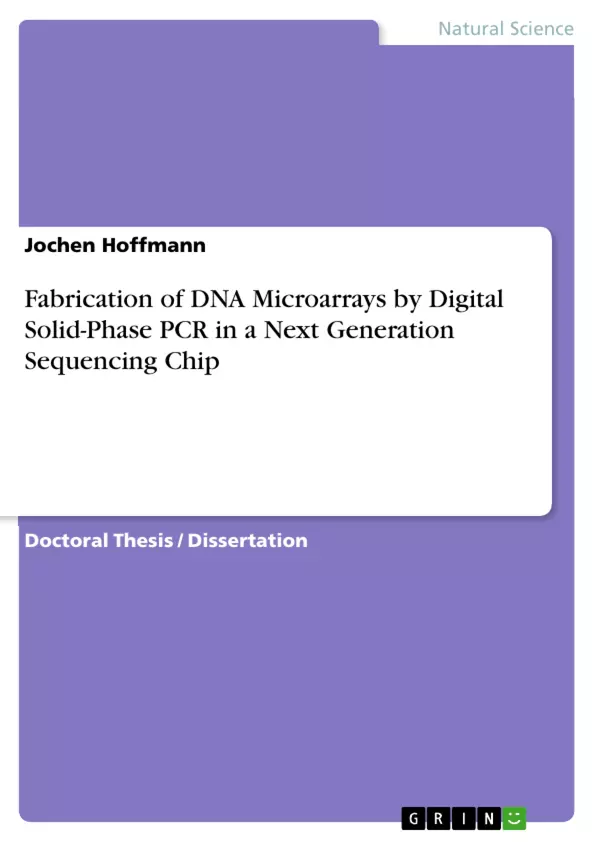
Fabrication of DNA Microarrays by Digital Solid-Phase PCR in a Next Generation Sequencing Chip
Doktorarbeit / Dissertation, 2013
124 Seiten, Note: 1,0
Leseprobe
Inhaltsverzeichnis (Table of Contents)
- Abstract
- 1. Introduction
- 2. State of the Art
- 3. Materials and Methods
- 3.1. DNA Microarray Fabrication
- 3.2. Immobilization of PCR Primers onto Microscope Slides
- 3.3. Solid-Phase PCR (SP-PCR) on Microscope Slides
- 3.4. On-Chip PCR
- 3.5. Digital Solid-Phase PCR (dSP-PCR) in a PicoTiterPlate (PTP)
- 3.6. DNA Microarray Replication
- 4. Results and Discussion
- 4.1. Immobilization of PCR Primers onto Microscope Slides
- 4.2. Solid-Phase PCR (SP-PCR) on Microscope Slides
- 4.3. On-Chip PCR
- 4.4. Digital Solid-Phase PCR (dSP-PCR) in a PicoTiterPlate (PTP)
- 4.5. DNA Microarray Replication
- 5. Conclusion
- 6. Outlook
- References
Zielsetzung und Themenschwerpunkte (Objectives and Key Themes)
This dissertation presents a novel process for the fabrication of DNA microarrays using a next-generation sequencing chip. The main objective is to develop a method for replicating DNA microarrays from a master microarray generated by digital solid-phase PCR in a PicoTiterPlate (PTP).
- Immobilization of PCR primers onto various materials
- Solid-phase PCR (SP-PCR) on different substrates
- Digital solid-phase PCR (dSP-PCR) in a PTP
- DNA microarray replication
- Minimizing carry-over DNA contamination in dSP-PCR
Zusammenfassung der Kapitel (Chapter Summaries)
- Chapter 1: Introduction This chapter introduces the concept of DNA microarrays and their applications. It discusses the limitations of traditional DNA microarray fabrication methods and highlights the potential of using next-generation sequencing chips for this purpose.
- Chapter 2: State of the Art This chapter provides a comprehensive overview of the existing technologies for DNA microarray fabrication, including the use of solid-phase PCR and digital PCR. It also reviews the different methods for immobilizing PCR primers onto surfaces.
- Chapter 3: Materials and Methods This chapter details the materials and methods used in the dissertation. It describes the fabrication process of DNA microarrays using a PicoTiterPlate (PTP) and the different steps involved, including primer immobilization, solid-phase PCR, and DNA microarray replication.
- Chapter 4: Results and Discussion This chapter presents the results of the experiments conducted in the dissertation. It analyzes the efficiency of different methods for primer immobilization, solid-phase PCR, and digital solid-phase PCR. It also discusses the challenges and solutions related to carry-over DNA contamination in dSP-PCR.
Schlüsselwörter (Keywords)
DNA microarrays, next-generation sequencing, solid-phase PCR, digital PCR, PicoTiterPlate (PTP), primer immobilization, DNA replication, carry-over DNA, microfluidic devices, biofabrication.
Details
- Titel
- Fabrication of DNA Microarrays by Digital Solid-Phase PCR in a Next Generation Sequencing Chip
- Hochschule
- Albert-Ludwigs-Universität Freiburg (Institut für Mikrosystemtechnik)
- Veranstaltung
- Mikrosystemtechnik
- Note
- 1,0
- Autor
- Dipl.- Ing. Jochen Hoffmann (Autor:in)
- Erscheinungsjahr
- 2013
- Seiten
- 124
- Katalognummer
- V300928
- ISBN (eBook)
- 9783656978275
- ISBN (Buch)
- 9783656978282
- Dateigröße
- 4569 KB
- Sprache
- Englisch
- Schlagworte
- fabrication
- Produktsicherheit
- GRIN Publishing GmbH
- Preis (Ebook)
- US$ 39,99
- Preis (Book)
- US$ 51,99
- Arbeit zitieren
- Dipl.- Ing. Jochen Hoffmann (Autor:in), 2013, Fabrication of DNA Microarrays by Digital Solid-Phase PCR in a Next Generation Sequencing Chip, München, Page::Imprint:: GRINVerlagOHG, https://www.diplomarbeiten24.de/document/300928
- Autor werden
- Ihre Optionen
- Vertriebskanäle
- Premium Services
- Autorenprofil
- Textarten und Formate
- Services für Verlage, Hochschulen, Unternehmen

- © GRIN Publishing GmbH.
- Alle Inhalte urheberrechtlich geschützt. Kopieren und verbreiten untersagt.
- info@grin.com
- AGB
- Open Publishing
Der GRIN Verlag hat sich seit 1998 auf die Veröffentlichung akademischer eBooks und Bücher spezialisiert. Der GRIN Verlag steht damit als erstes Unternehmen für User Generated Quality Content. Die Verlagsseiten GRIN.com, Hausarbeiten.de und Diplomarbeiten24 bieten für Hochschullehrer, Absolventen und Studenten die ideale Plattform, wissenschaftliche Texte wie Hausarbeiten, Referate, Bachelorarbeiten, Masterarbeiten, Diplomarbeiten, Dissertationen und wissenschaftliche Aufsätze einem breiten Publikum zu präsentieren.
Kostenfreie Veröffentlichung: Hausarbeit, Bachelorarbeit, Diplomarbeit, Dissertation, Masterarbeit, Interpretation oder Referat jetzt veröffentlichen!
- GRIN Verlag GmbH
-
- Nymphenburger Str. 86
- 80636
- Munich, Deutschland
- +49 89-550559-0
- +49 89-550559-10
- info@grin.com
-









